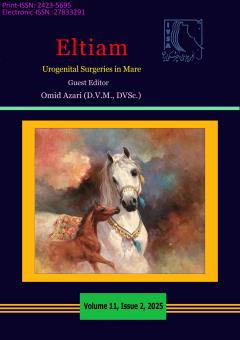Urethroplasty in Mares: Methods and Challenges
Subject Areas : علوم جراحی دامپزشکی شامل جراحی های بافت های سخت و نرم
Mahdi ghamsari
1
,
Mohammad mahdi Ashjaei
2
![]()
1 - Department of surgery and radiology, Veterinary faculty, University of Tehran, Tehran, Iran.
2 - Department of surgery and radiology, Veterinary faculty, University of Tehran, Tehran, Iran.
Keywords: Urethroplasty, Urovagina, Infertility, Subfertility,
Abstract :
Background: Urinary and reproductive tract disorders in mares can severely impact their health and fertility. One of the major concerns is urovagina, where urine accumulates in the vaginal canal, leading to infertility and reproductive infections. This study reviews urethroplasty techniques for correcting these abnormalities.
Objectives: This study aims to evaluate various urethroplasty techniques, particularly different urethral extension methods, to address urinary tract abnormalities in mares. Additionally, it compares these techniques and analyzes their advantages and limitations.
Methods: A literature review was conducted using sources from reputable national and international journals, conferences, and reference books on large animal surgery, obstetrics, and reproduction.
Results: Urethroplasty has been shown to be an effective surgical method for addressing urovagina and urine reflux issues in mares. The most commonly used techniques include:
- Monin Technique: Best suited for mild cases, this method repositions the transverse fold to prevent urine entry into the vagina. While simple, it has limitations in fully correcting the issue.
- Brown Technique: Involves a U-shaped incision to extend the urethral outlet, making it effective for severe urovagina cases. However, mucosal incisions increase the risk of bleeding.
- Shires Technique: A minimally invasive approach that stretches vestibular mucosa without incisions. It reduces bleeding risks but may be less effective for severe conditions.
- McKinnon Technique: Uses large mucosal flaps to create a new tunnel, providing a durable solution. However, it involves extensive incisions and a higher risk of bleeding.
The success of urethroplasty depends on the severity of the abnormality, the mare’s anatomy, and the surgeon’s expertise. Challenges such as fistula formation, intraoperative bleeding, and suture dehiscence may affect outcomes.
